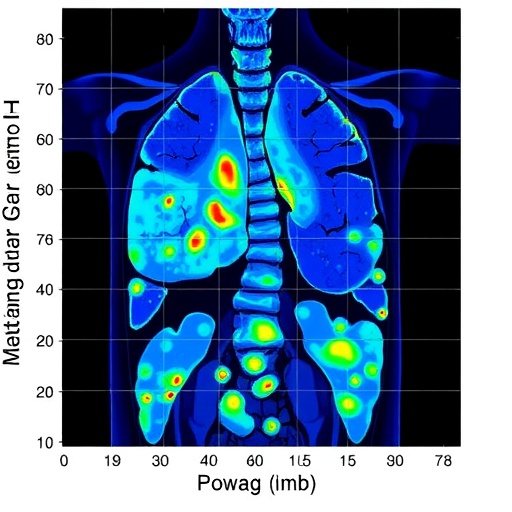Hepatocellular carcinoma (HCC), a primary malignancy of the liver, presents one of the most challenging prognostic dilemmas in the realm of oncology. This complexity arises primarily due to the multifaceted nature of the disease, which often leads to late-stage diagnosis and consequently, poor patient outcomes. Recent research has illuminated a pathway forward, leveraging advanced computational techniques to develop predictive models that can significantly enhance clinical decision-making. A pivotal study conducted by Liu et al. highlights the potential of integrating clinical data, radiomics, and deep learning to predict distant metastasis following transarterial chemoembolization (TACE) in patients afflicted with HCC.
The groundwork for this innovative study was laid by recognizing the critical need for accurate prognostic tools. TACE is often employed as a standard treatment for unresectable HCC, with the objective of prolonging survival. However, not all patients benefit equally from this intervention, as a subset may go on to develop distant metastases. The ability to identify such high-risk patients preemptively could dramatically alter the therapeutic landscape, enabling clinicians to tailor management strategies to maximize treatment efficacy and minimize unnecessary interventions.
In order to construct the model, the researchers meticulously collected a robust dataset comprising clinical characteristics, imaging results, and patient outcomes. This multifaceted approach ensured a comprehensive analysis of the factors influencing metastasis. Radiomics, a burgeoning field that extracts vast amounts of quantitative features from medical images, played a fundamental role in this research. By analyzing texture, shape, and intensity variations within tumor imaging, the study allowed for a more granular understanding of tumor heterogeneity, which is crucial in predicting behavior.
Deep learning algorithms were employed to process and interpret these extensive datasets. The unique architecture of deep learning models enables them to identify intricate patterns and relationships within data that may be imperceptible to the human eye. The researchers utilized convolutional neural networks (CNNs), which are particularly adept at image analysis, to evaluate the radiomic features alongside clinical variables. This synergy between advanced imaging analytics and machine learning exemplifies the frontier of personalized medicine, where data-driven insights can lead to tailored patient management.
As the study progressed, the researchers performed a rigorous validation of the predictive model. This stage was vital to ensure that the model did not just excel in a controlled environment but could also maintain its accuracy when applied to external patient populations. The validation process underscored the model’s effectiveness in real-world scenarios, affirming its potential role as a clinical tool for oncologists seeking to stratify patients based on their risk of distant metastasis.
One of the remarkable findings of Liu et al. was the identification of specific radiomic features that significantly correlated with adverse outcomes. This adds a layer of understanding that could potentially reshape clinical practices. For instance, features reflecting tumor aggressiveness and vascular characteristics could guide oncologists in refining treatment strategies. The implications are profound; by shifting the focus from a one-size-fits-all treatment approach to a more individualized strategy, the likelihood of successful interventions increases.
Additionally, the incorporation of clinical data into the model enriched the predictive framework. Factors such as patient age, liver function, and tumor size were all considered, providing a holistic view of the patient’s health status. This integrative approach emphasizes the necessity of viewing patients as complex biological systems rather than isolated cases, thus ensuring better prognostic accuracy.
The potential for this predictive model to alter patient outcomes cannot be overstated. By effectively predicting which patients might develop distant metastases, healthcare providers can proactively change treatment protocols, consider alternative therapies, or, in some cases, escalate treatment sooner. This could lead to not just improved survival rates but also a significant enhancement in the quality of life for those affected by HCC.
Furthermore, the societal implications of such advancements are remarkable. As cancer care continues to evolve towards data-driven methodologies, the ability to predict outcomes accurately could alleviate some of the burdens on healthcare systems. More accurate predictions lead to better resource allocation, reduced costs associated with unnecessary treatments, and ultimately a higher standard of care for patients facing potentially terminal diseases.
The researchers underscore that while their model is a significant leap forward, ongoing efforts are required to fine-tune and validate the findings further. The landscape of cancer research is ever-evolving, and the integration of new data, advancements in machine learning, and broader clinical trials will all contribute to refining such predictive tools. Continuous improvement will be essential to maintain the relevance and effectiveness of these models in a clinical setting.
In conclusion, the fusion of clinical data, radiomics, and deep learning in this study represents a groundbreaking approach to understanding and managing hepatocellular carcinoma. The implications for patient care are vast, potentially altering treatment paradigms and impacting survival rates. As research continues to explore the depths of machine learning and imaging science, the future of oncology may undoubtedly be shaped by such innovative predictive models.
In the quest to advance cancer treatment, Liu et al.’s findings illuminate a promising path, inviting further exploration and refinement of predictive analytics in the medical domain. The integration of technology and clinical practice stands as a beacon of hope for numerous patients battling cancer, heralding a new era of personalized and precise oncology.
Subject of Research: Predictive modeling for distant metastasis in hepatocellular carcinoma (HCC) patients.
Article Title: Development of a predictive model for distant metastasis in HCC patients post-TACE using clinical data, radiomics, and deep learning.
Article References: Liu, C., Han, L., Ding, X. et al. Development of a predictive model for distant metastasis in HCC patients post-TACE using clinical data, radiomics, and deep learning. J Cancer Res Clin Oncol 151, 258 (2025). https://doi.org/10.1007/s00432-025-06308-5
Image Credits: AI Generated
DOI:
Keywords: Predictive modeling, hepatocellular carcinoma, deep learning, radiomics, distant metastasis, transarterial chemoembolization, personalized medicine, oncology.




